Chenyu Wu
Super-resolution Wideband Beam Training for Near-field Communications with Ultra-low Overhead
Apr 27, 2025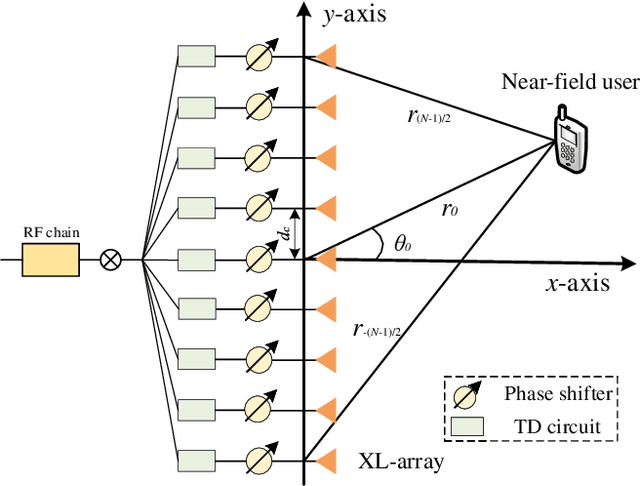
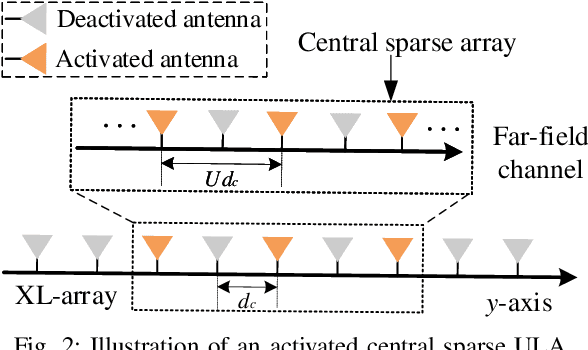
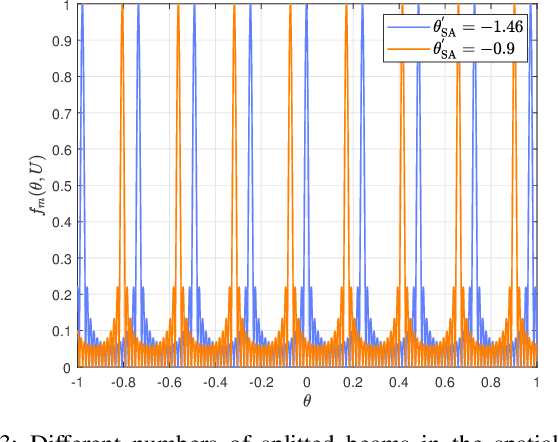
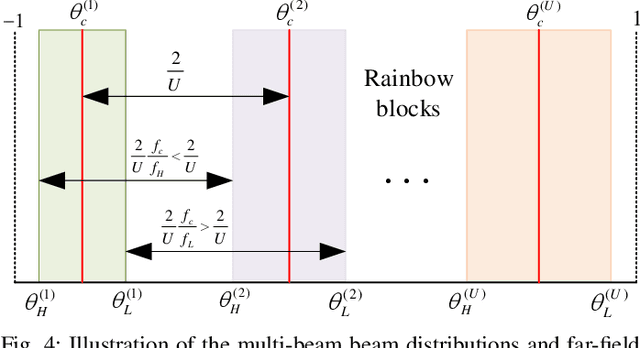
Abstract:In this paper, we propose a super-resolution wideband beam training method for near-field communications, which is able to achieve ultra-low overhead. To this end, we first study the multi-beam characteristic of a sparse uniform linear array (S-ULA) in the wideband. Interestingly, we show that this leads to a new beam pattern property, called rainbow blocks, where the S-ULA generates multiple grating lobes and each grating lobe is further splitted into multiple versions in the wideband due to the well-known beam-split effect. As such, one directional beamformer based on S-ULA is capable of generating multiple rainbow blocks in the wideband, hence significantly extending the beam coverage. Then, by exploiting the beam-split effect in both the frequency and spatial domains, we propose a new three-stage wideband beam training method for extremely large-scale array (XL-array) systems. Specifically, we first sparsely activate a set of antennas at the central of the XL-array and judiciously design the time-delay (TD) parameters to estimate candidate user angles by comparing the received signal powers at the user over subcarriers. Next, to resolve the angular ambiguity introduced by the S-ULA, we activate all antennas in the central subarray and design an efficient subcarrier selection scheme to estimate the true user angle. In the third stage, we resolve the user range at the estimated user angle with high resolution by controlling the splitted beams over subcarriers to simultaneously cover the range domain. Finally, numerical results are provided to demonstrate the effectiveness of proposed wideband beam training scheme, which only needs three pilots in near-field beam training, while achieving near-optimal rate performance.
Semantic Latent Motion for Portrait Video Generation
Mar 13, 2025



Abstract:Recent advancements in portrait video generation have been noteworthy. However, existing methods rely heavily on human priors and pre-trained generation models, which may introduce unrealistic motion and lead to inefficient inference. To address these challenges, we propose Semantic Latent Motion (SeMo), a compact and expressive motion representation. Leveraging this representation, our approach achieve both high-quality visual results and efficient inference. SeMo follows an effective three-step framework: Abstraction, Reasoning, and Generation. First, in the Abstraction step, we use a carefully designed Mask Motion Encoder to compress the subject's motion state into a compact and abstract latent motion (1D token). Second, in the Reasoning step, long-term modeling and efficient reasoning are performed in this latent space to generate motion sequences. Finally, in the Generation step, the motion dynamics serve as conditional information to guide the generation model in synthesizing realistic transitions from reference frames to target frames. Thanks to the compact and descriptive nature of Semantic Latent Motion, our method enables real-time video generation with highly realistic motion. User studies demonstrate that our approach surpasses state-of-the-art models with an 81% win rate in realism. Extensive experiments further highlight its strong compression capability, reconstruction quality, and generative potential. Moreover, its fully self-supervised nature suggests promising applications in broader video generation tasks.
Near-field Beam Training with Sparse DFT Codebook
Jun 06, 2024



Abstract:Extremely large-scale array (XL-array) has emerged as one promising technology to improve the spectral efficiency and spatial resolution of future sixth generation (6G) wireless systems.The upsurge in the antenna number antennas renders communication users more likely to be located in the near-field region, which requires a more accurate spherical (instead of planar) wavefront propagation modeling.This inevitably incurs unaffordable beam training overhead when performing a two-dimensional (2D) beam-search in both the angular and range domains.To address this issue, we first introduce a new sparse discrete Fourier transform (DFT) codebook, which exhibits the angular periodicity in the received beam pattern at the user, which motivates us to propose a three-phase beam training scheme.Specifically, in the first phase, we utilize the sparse DFT codebook for beam sweeping in an angular subspace and estimate candidate user angles according to the received beam pattern.Then, a central sub-array is activated to scan specific candidate angles for resolving the issue of angular ambiguity and identity the user angle.In the third phase, the polar-domain codebook is applied in the estimated angle to search the best effective range of the user.Finally, numerical results show that the proposed beam training scheme enabled by sparse DFT codebook achieves 98.67% reduction as compared with the exhaustive-search scheme, yet without compromising rate performance in the high signal-to-ratio (SNR) regime.
Semantic-Relay-Aided Text Transmission: Placement Optimization and Bandwidth Allocation
Nov 16, 2023



Abstract:Semantic communication has emerged as a promising technology to break the Shannon limit by extracting the meaning of source data and sending relevant semantic information only. However, some mobile devices may have limited computation and storage resources, which renders it difficult to deploy and implement the resource-demanding deep learning based semantic encoder/decoder. To tackle this challenge, we propose in this paper a new semantic relay (SemRelay), which is equipped with a semantic receiver for assisting text transmission from a resource-abundant base station (BS) to a resource-constrained mobile device. Specifically, the SemRelay first decodes the semantic information sent by the BS (with a semantic transmitter) and then forwards it to the user by adopting conventional bit transmission, hence effectively improving the text transmission efficiency. We formulate an optimization problem to maximize the achievable (effective) bit rate by jointly designing the SemRelay placement and bandwidth allocation. Although this problem is non-convex and generally difficult to solve, we propose an efficient penalty-based algorithm to obtain a high-quality suboptimal solution. Numerical results show the close-to-optimal performance of the proposed algorithm as well as significant rate performance gain of the proposed SemRelay over conventional decode-and-forward relay.
Near-Field Beam Management for Extremely Large-Scale Array Communications
Jun 28, 2023Abstract:Extremely large-scale arrays (XL-arrays) have emerged as a promising technology to achieve super-high spectral efficiency and spatial resolution in future wireless systems. The large aperture of XL-arrays means that spherical rather than planar wavefronts must be considered, and a paradigm shift from far-field to near-field communications is necessary. Unlike existing works that have mainly considered far-field beam management, we study the new near-field beam management for XL-arrays. We first provide an overview of near-field communications and introduce various applications of XL-arrays in both outdoor and indoor scenarios. Then, three typical near-field beam management methods for XL-arrays are discussed: near-field beam training, beam tracking, and beam scheduling. We point out their main design issues and propose promising solutions to address them. Moreover, other important directions in near-field communications are also highlighted to motivate future research.
Two-Stage Hierarchical Beam Training for Near-Field Communications
Feb 24, 2023



Abstract:Extremely large-scale array (XL-array) has emerged as a promising technology to improve the spectrum efficiency and spatial resolution of future wireless systems. However, the huge number of antennas renders the users more likely to locate in the near-field (instead of the far-field) region of the XL-array with spherical wavefront propagation. This inevitably incurs prohibitively high beam training overhead since it requires a two-dimensional (2D) beam search over both the angular and distance domains. To address this issue, we propose in this paper an efficient two-stage hierarchical beam training method for near-field communications. Specifically, in the first stage, we employ the central sub-array of the XL-array to search for a coarse user direction in the angular domain with conventional far-field hierarchical codebook. Then, in the second stage, given the coarse user direction, we progressively search for the fine-grained user direction-and-distance in the polar domain with a dedicatedly designed codebook. Numerical results show that our proposed two-stage hierarchical beam training method can achieve over 99% training overhead reduction as compared to the 2D exhaustive search, yet achieving comparable rate performance.
Two-Timescale Design for STAR-RIS Aided NOMA Systems
Jul 02, 2022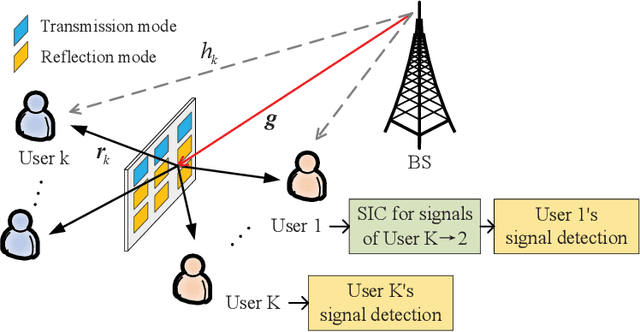
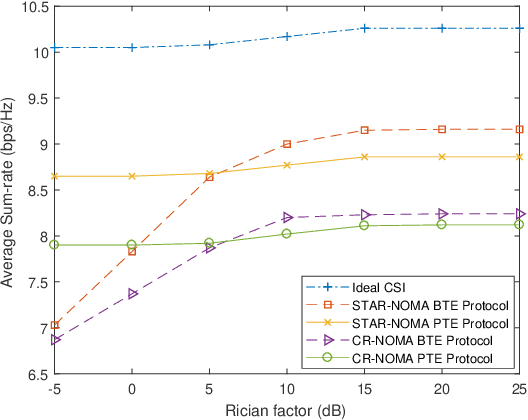


Abstract:Simultaneously transmitting and reflecting reconfigurable intelligent surfaces (STAR-RISs) have emerged as a promising technology for achieving full-space coverage. Prior works on STAR-RISs mostly assumed the full and instantaneous channel state information (CSI) is available, which, however, is practically difficult to obtain due to the large number of elements. To address it, we investigate STAR-RIS aided NOMA systems, where two efficient two-timescale transmission protocols are proposed for different channel setups to maximize the average sum-rate. Specifically, 1) for line-of-sight (LoS) dominant channels, we propose the beamforming-then-estimate (BTE) Protocol, where the long-term STAR-RIS coefficients are optimized based on the statistical CSI, while the short-term power allocation at the base station (BS) is designed based on the effective channels; 2) for the rich scattering environment, we propose an alternative partition-then-estimate (PTE) Protocol, where the BS determines the long-term STAR-RIS surface-partition strategy; then the BS estimates the instantaneous subsurface channels and designs its power allocation and STAR-RIS phase-shifts accordingly. Simulation results validate the superiority of our proposed transmission protocols as compared to various benchmarks. It is shown that the BTE Protocol outperforms the PTE Protocol when the number of STAR-RIS elements is large and/or the LoS channel components are dominant, and vice versa.
Channel Estimation for STAR-RIS-aided Wireless Communication
Dec 02, 2021
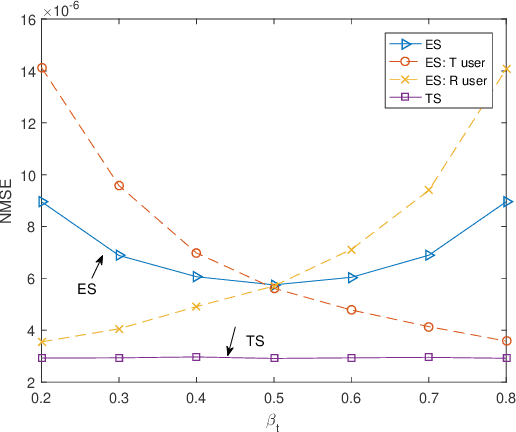
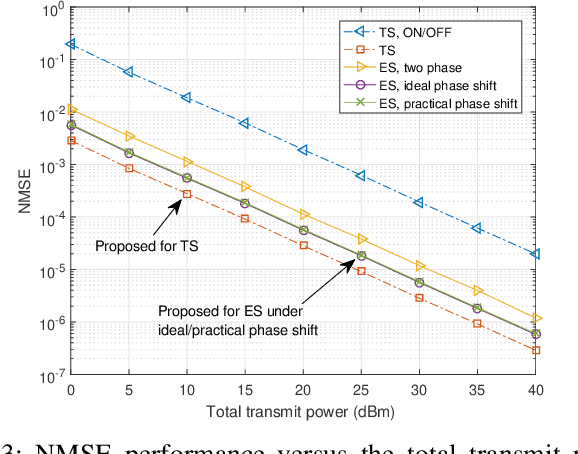
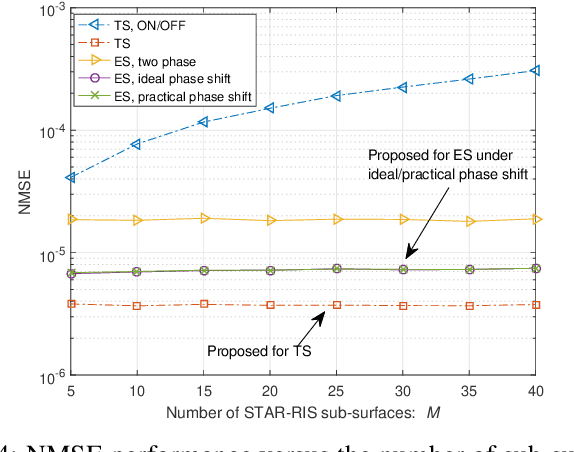
Abstract:In this letter, we study efficient uplink channel estimation design for a simultaneously transmitting and reflecting reconfigurable intelligent surface (STAR-RIS) assisted two-user communication systems. We first consider the time switching (TS) protocol for STAR-RIS and propose an efficient scheme to separately estimate the channels of the two users with optimized training (transmission/reflection) pattern. Next, we consider the energy splitting (ES) protocol for STAR-RIS under the practical coupled phase-shift model and devise a customized scheme to simultaneously estimate the channels of both users. Although the problem of minimizing the resultant channel estimation error for the ES protocol is difficult to solve, we propose an efficient algorithm to obtain a high-quality solution by jointly designing the pilot sequences, power-splitting ratio, and training patterns. Numerical results show the effectiveness of the proposed channel estimation designs and reveal that the STAR-RIS under the TS protocol achieves a smaller channel estimation error than the ES case.
Resource Allocation in STAR-RIS-Aided Networks: OMA and NOMA
Nov 06, 2021

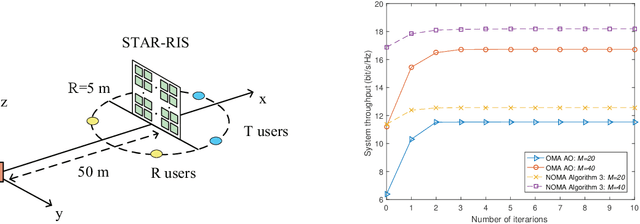
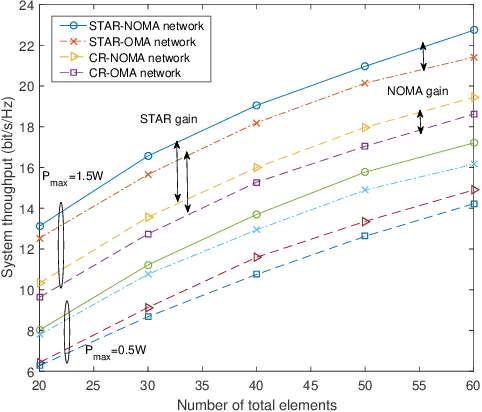
Abstract:Simultaneously transmitting and reflecting reconfigurable intelligent surface (STAR-RIS) is a promising technology to achieve full-space coverage. This paper investigates the resource allocation problem in a STAR-RIS-assisted multi-carrier communication network. To maximize the system sum-rate, a joint optimization problem for orthogonal multiple access (OMA) is first formulated, which is a mixed-integer non-linear programming problem. To solve this challenging problem, we first propose a channel assignment scheme utilizing matching theory and then invoke the alternating optimization-based method to optimize the resource allocation policy and beamforming vectors iteratively. Furthermore, the sum-rate maximization problem for non-orthogonal multiple access (NOMA) is investigated. To efficiently solve it, we first propose a location-based matching algorithm to determine the sub-channel assignment, where a transmitted user and a reflected user are grouped on a sub-channel. Then, a three-step approach is proposed, where the decoding orders, beamforming-coefficient vectors, and power allocation are optimized by employing semidefinite programming, convex upper bound approximation, and geometry programming, respectively. Numerical results unveil that: 1) For OMA, a general design that includes same-side user-pairing for channel assignment is preferable, while for NOMA, the proposed transmission-and-reflection scheme can achieve near-optimal performance. 2) The STAR-RIS-aided NOMA network significantly outperforms the networks employing conventional RISs and OMA.
Coverage Characterization of STAR-RIS Networks: NOMA and OMA
Apr 20, 2021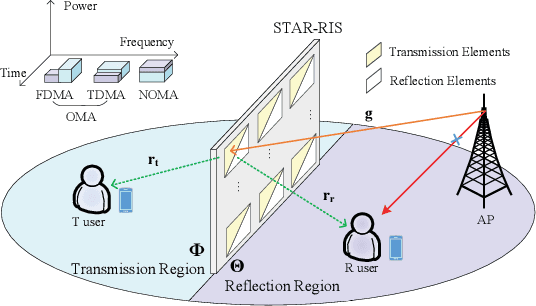
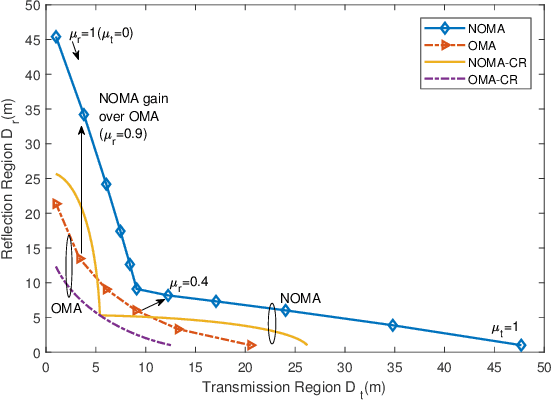

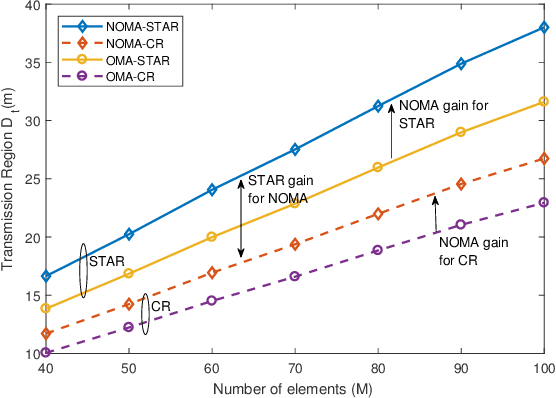
Abstract:The novel concept of simultaneously transmitting and reflecting reconfigurable intelligent surface (STAR-RIS) is investigated, where incident signals can be transmitted and reflected to users located at different sides of the surface. In particular, the fundamental coverage range of STAR-RIS aided two-user communication networks is studied. A sum coverage range maximization problem is formulated for both non-orthogonal multiple access (NOMA) and orthogonal multiple access (OMA), where the resource allocation at the access point and the transmission and reflection coefficients at the STAR-RIS are jointly optimized to satisfy the communication requirements of users. For NOMA, we transform the non-convex decoding order constraint into a linear constraint and the resulting problem is convex, which can be optimally solved. For OMA, we first show that the optimization problem for given time/frequency resource allocation is convex. Then, we employ the one dimensional search-based algorithm to obtain the optimal solution. Numerical results reveal that the coverage can be significantly extended by the STAR-RIS compared with conventional RISs.
 Add to Chrome
Add to Chrome Add to Firefox
Add to Firefox Add to Edge
Add to Edge